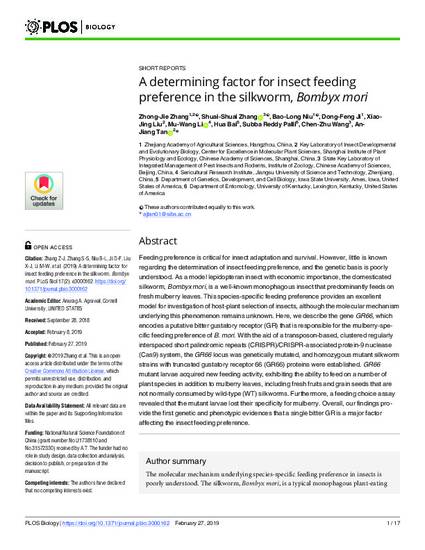
Feeding preference is critical for insect adaptation and survival. However, little is known regarding the determination of insect feeding preference, and the genetic basis is poorly understood. As a model lepidopteran insect with economic importance, the domesticated silkworm, Bombyx mori, is a well-known monophagous insect that predominantly feeds on fresh mulberry leaves. This species-specific feeding preference provides an excellent model for investigation of host-plant selection of insects, although the molecular mechanism underlying this phenomenon remains unknown. Here, we describe the gene GR66, which encodes a putative bitter gustatory receptor (GR) that is responsible for the mulberry-specific feeding preference of B. mori. With the aid of a transposon-based, clustered regularly interspaced short palindromic repeats (CRISPR)/CRISPR-associated protein-9 nuclease (Cas9) system, the GR66 locus was genetically mutated, and homozygous mutant silkworm strains with truncated gustatory receptor 66 (GR66) proteins were established. GR66 mutant larvae acquired new feeding activity, exhibiting the ability to feed on a number of plant species in addition to mulberry leaves, including fresh fruits and grain seeds that are not normally consumed by wild-type (WT) silkworms. Furthermore, a feeding choice assay revealed that the mutant larvae lost their specificity for mulberry. Overall, our findings provide the first genetic and phenotypic evidences that a single bitter GR is a major factor affecting the insect feeding preference.
Available at: http://works.bepress.com/hua-bai/21/

This article is published as Zhang Z-J, Zhang S-S, Niu B-L, Ji D-F, Liu X-J, Li M-W, et al. (2019) A determining factor for insect feeding preference in the silkworm, Bombyx mori. PLoS Biol 17(2): e3000162. doi: 10.1371/journal.pbio.3000162.